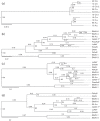Whole-genome sequences of Odocoileus hemionus deer adenovirus isolates from deer, moose and elk are highly conserved and support a new species in the genus Atadenovirus
- PMID: 28809152
- PMCID: PMC5656758
- DOI: 10.1099/jgv.0.000880
Whole-genome sequences of Odocoileus hemionus deer adenovirus isolates from deer, moose and elk are highly conserved and support a new species in the genus Atadenovirus
Abstract
We present the first complete genome sequence of Odocoileus hemionus deer adenovirus 1 (OdAdV-1). This virus can cause sporadic haemorrhagic disease in cervids, although epizootics with high mortality have occurred in California. OdAdV-1 has been placed in the genus Atadenovirus, based on partial hexon, pVIII and fibre genes. Ten field isolates recovered from naturally infected mule deer (Odocoileus hemionus), white-tailed deer (Odocoileus virginiana) and moose (Alces alces) from Wyoming, black-tailed deer (Odocoileus hemionus columbianus) from California, and Rocky Mountain elk (Cervus elaphus nelsoni) from Colorado and Washington state were sequenced. The genome lengths ranged from 30 620 to 30 699 bp, contained the predicted proteins and gene organization typical of members of genus Atadenovirus, and had a high percentage of A/T nucleotides (66.7 %). Phylogenic analysis found that the closest ancestry was with ruminant atadenoviruses, while a divergence of the hexon, polymerase and penton base proteins of more than 15 % supports classification as a new species. Genetic global comparison between the 10 isolates found an overall 99 % identity, but greater divergence was found between those recovered from moose and elk as compared to deer, and a single variable region contained most of these differences. Our findings demonstrate that OdAdV-1 is highly conserved between 10 isolates recovered from multiple related cervid species, but genotypic differences, largely localized to a variable region, define two strains. We propose that the virus type name be changed to cervid adenovirus 1, with the species name Cervid atadenovirus A. Sequence data were used to develop molecular assays for improved detection and genotyping.
Figures



References
-
- MacLachlan NJ, Dubovi EJ, Fenner F. Fenner's Veterinary Virology. 4th ed. Amsterdam, Boston: Elsevier/AP; 2011. pp. 203–212.
MeSH terms
LinkOut - more resources
Full Text Sources
Other Literature Sources

